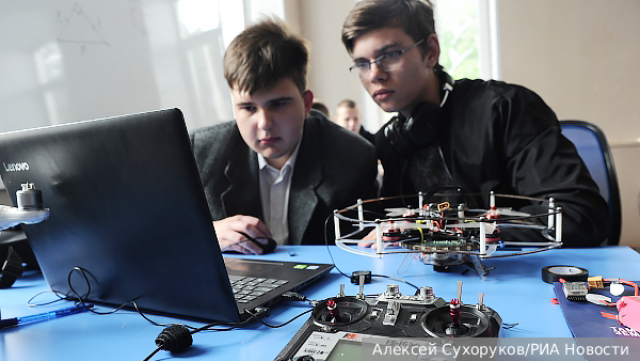School leavers now prefer to go to colleges rather than universities
A truly radical revolution took place in Russian education imperceptibly. Colleges – they are also former vocational schools, vocational schools – have become prestigious and popular. How did this happen and in what words do the former students themselves explain their changed preferences?
The history of rivalry between the systems of higher and secondary vocational education (SPE) in our country has known everything. In Soviet times, few people got into universities – no more than 20% of those who graduated from school. All the others went to the system of primary and secondary vocational education or directly to production. And they could only dream of higher education.
In the 1990s and 2000s, the situation radically changed. At that time, up to 100% of the school's graduates became university students. And a number of admission campaigns ended with the recruitment to universities not only of almost all yesterday's eleventh graders, but also many of those who did not pass the competition in the past. And the number of students then soared to 102-103% of the current year's school graduation, leaving the population with a heavy sense of sur.
Those decades were the lowest point of the decline of Russian vocational education. Its state funding was approaching zero, the equipment and curricula of vocational schools and technical schools looked outdated for almost half a century, teachers fled, and students did not learn anything worthwhile. Middle–aged people probably remember how they were scared at home: "If you study poorly at school, you will go to vocational school!" And it was not an empty threat.
It seemed that the domestic PDF system had come to an end, and it could not rise any more. But since the mid-2010s, the situation has begun to change.
The first sign in 2012 was the accession of Russia to the WorldSkills international movement and the transfer of training of highly qualified workers and mid-level specialists to modern international standards. At first, it affected individual specialties and professions that were taught in individual colleges. But then the circle of participants expanded. And soon a group of leaders was formed, which everyone began to focus on.
The innovations were immediately supported by employers who were in dire need of high-quality specialists. At first timidly, and then on an ever-larger scale, they were involved in the development of relevant curricula, and then in the re-equipment of technical schools and colleges with modern educational equipment.
The financing of the PDF system has also increased. Budget funds no longer disappeared into the "black hole" of total collapse, but actually – and in increasing volumes – went to training personnel in demand by the economy. Private employers have also begun to invest in the SPO system.
And the totality of the measures taken worked. By the early 2020s, Russian secondary vocational education had been modernized to such an extent that the changes were felt and appreciated by society. Since then, the number of those wishing to go to college has been growing every year, and the popularity of higher education, respectively, has been falling.
According to official data, already in 2022, the number of college and technical school applicants exceeded the number of those wishing to enroll in universities. As the "Teacher's Newspaper" clarifies, on September 1, 2022, 800 thousand first-year students sat at college desks, in total, 3.45 million students were studying in Russian colleges at that time.
Nursing, information systems and programming, specialties of cooks, confectioners, as well as maintenance and repair of engines, systems and aggregates of cars were among the most popular areas of training in the SPO system by applicants.
Information technologies are also extremely popular among college applicants. 275 thousand students receive IT education there, and colleges train specialists in 12 different IT areas.
As for higher education, according to the Cabinet of Ministers, 651,840 first-year students enrolled in bachelor's and specialty programs in 2022. And this year continued the emerging trend. "Today, most schoolchildren choose secondary vocational education!" stated Viktor Neumyvakin, Director of the Department of State Policy in the Field of Secondary Vocational Education and Vocational Training of the Ministry of Education of Russia at the recent Moscow Urban Forum. His words are confirmed by the Minister of Education of Russia Sergey Kravtsov, who summed up the results of the entrance campaign of 2023:
"Colleges have overtaken higher education institutions in terms of the number of applicants."
Meanwhile, the improvement of the PDF system continues. In 2022, the federal project "Professionalism" was launched, designed to ensure a complete restart of qualified mid-level specialists by 2030. The basis of this model will be the creation of educational and production centers (clusters), involving the integration of colleges and organizations of the relevant sector of the economy. And as a result – personnel training, completely closed to the real needs of the economy.
However, not all PDF institutions have been affected by the changes so far. But the graduates of the school, as evidenced by the entrant chats, already managed to evaluate the updated PDF system. And, as they say, they began to actively vote for her "with their feet".
"The cost of studying in colleges is an order of magnitude less than in good universities; there is no ill-fated USE and expensive preparation for it (admission is carried out according to the average score of the certificate); the choice of professions is as diverse as in universities; a closer link of colleges with employers, which guarantees students employment and the relevance of curricula with an emphasis on practical classes, not theoretical verbiage at universities; finding a profession and entering into working life two or three years earlier than at universities; equivalence in conditions of acute shortage of working personnel for employers of diplomas of vocational education and higher education; the absence of a tangible difference in the salary of graduates" - this is how the applicants themselves explain the advantages of modern vocational education.


